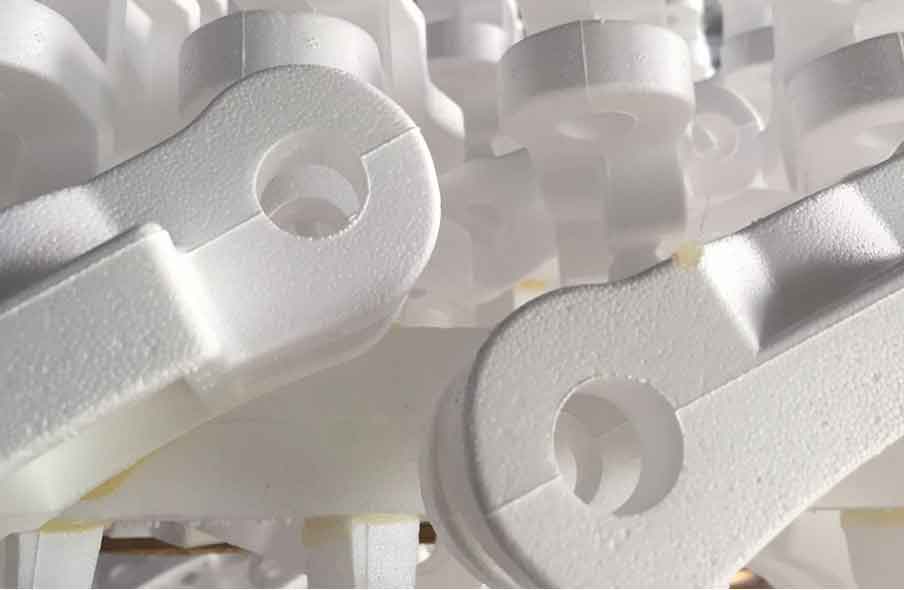The graphite in gray cast iron is flake, which is the most widely used cast iron, and its output accounts for more than the total output of cast iron. According to the composition of the alloy, gray cast iron belongs to hypoeutectic alloy, and its primary phase during solidification is austenite. Therefore, the vibration lost foam casting process of gray cast iron was designed to study the effect of vibration on the microstructure and properties of lost foam casting gray cast iron, explore the mechanism of vibration on the primary austenite of lost foam casting gray cast iron, and construct the stress model of austenite dendrite during solidification.

The effects of vibration frequency, amplitude and sample wall thickness on the microstructure and properties of lost foam casting gray cast iron were experimentally studied, and the mechanism of microstructure transformation was analyzed and discussed. The conclusions are as follows:
- the effect of vibration frequency on the microstructure and properties of gray cast iron was studied under the condition of 3mm amplitude. When the vibration frequency increases from 0Hz to 35Hz, the length of flake graphite decreases. When the vibration frequency continues to increase above 50Hz, although the length of flake graphite gradually increases, the length of flake graphite of vibration lost foam casting gray cast iron is smaller than that of lost foam casting gray cast iron without vibration. In addition, vibration causes the primary austenite dendrite to break up, the austenite dendrite becomes underdeveloped and the grain size decreases. Moreover, the tensile strength and hardness of the gray cast iron prepared at the vibration frequency are larger.
- the change of solidification temperature of gray cast iron with time under the vibration frequency of 35Hz and without vibration was studied. The results show that the vibration increases the solidification undercooling of gray cast iron, reduces the critical nucleation radius of primary austenite during solidification, is conducive to the nucleation of primary austenite, and promotes the refinement of austenite grains in gray cast iron.
- the effect of amplitude on the microstructure and properties of gray cast iron in lost foam casting was studied under the condition that the reference frequency was 35Hz. When the amplitude increases from 0.75mm to 2mm, the length of flake graphite in grey cast iron decreases, the austenite dendrite arms become coarser and evenly distributed, forming an effective network skeleton in grey cast iron, hindering the deformation of metal, and making the tensile strength of grey cast iron larger, which is 247.51mpa. Compared with the gray cast iron without vibration, it increased by 26.25%. When the amplitude increases from 2mm to 3mm, although the length of flake graphite decreases, the energy required for fracture is reduced due to the thinning of austenite dendrite arm, which reduces the tensile strength of gray prayer iron. When the amplitude is further increased to 4mm, the austenite in grey cast iron is unevenly distributed, and the austenite network skeleton in grey cast iron is damaged by excessive vibration force, so the performance of grey cast iron is low.
- the relationship between austenite dendrite arm diameter, dendrite arm length and vibration process parameters was established, and the mechanical model of dendrite fracture of vibration lost foam casting gray cast iron was established according to the principles of material mechanics and fluid mechanics. When vibration is applied in the process of lost foam casting of gray cast iron, the greater the vibration frequency and amplitude, the greater the resultant force of bending stress on austenite dendrites, the greater the degree of fragmentation, and the smaller the austenite grain size.
- the effect of sample wall thickness on the microstructure and properties of gray cast iron was studied. When the wall thickness of the sample is small (20mm), the cooling speed of the sample is faster and the undercooling degree is larger. Type graphite appears in gray cast iron, while type graphite is not observed in gray cast iron with larger thickness (40mm and 60mm). The increase of sample wall thickness delayed the solidification of liquid metal, accelerated the diffusion rate of carbon atoms, increased the length of flake graphite, and the pearlite flake spacing in gray cast iron increased with the increase of wall thickness, which reduced the matrix hardness of gray cast iron.
